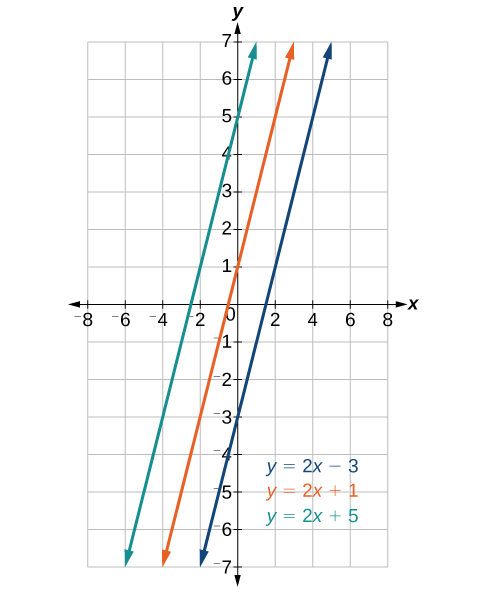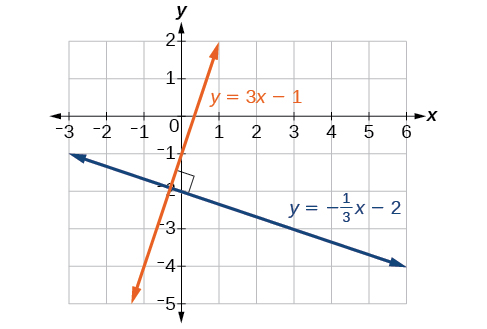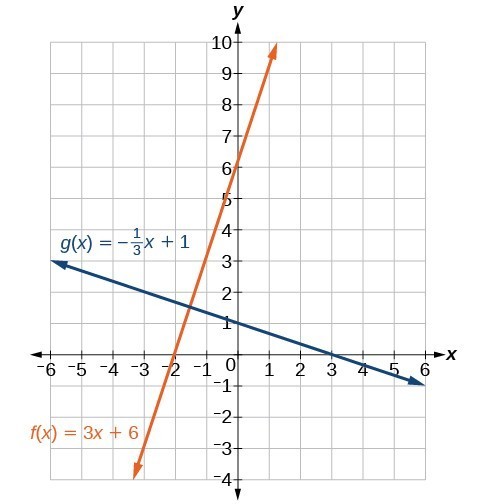Parallel and Perpendicular Lines
Learning Outcomes
- Determine whether two lines are parallel or perpendicular.
- Find the equations of parallel and perpendicular lines.
- Write the equations of lines that are parallel or perpendicular to a given line.
 Parallel lines have slopes that are the same.
Parallel lines have slopes that are the same.[latex]\begin{array}{l}\text{ }{m}_{1}\cdot {m}_{2}=-1\hfill \\ \text{ }3\cdot \left(-\frac{1}{3}\right)=-1\hfill \end{array}[/latex]
 Perpendicular lines have slopes that are negative reciprocals of each other.
Perpendicular lines have slopes that are negative reciprocals of each other.Example: Graphing Two Equations, and Determining Whether the Lines are Parallel, Perpendicular, or Neither
Graph the equations of the given lines and state whether they are parallel, perpendicular, or neither: [latex]3y=-4x+3[/latex] and [latex]3x - 4y=8[/latex].Answer: The first thing we want to do is rewrite the equations so that both equations are in slope-intercept form. First equation:
[latex]\begin{array}{l}3y=-4x+3\hfill \\ y=-\frac{4}{3}x+1\hfill \end{array}[/latex]
Second equation:[latex]\begin{array}{l}3x - 4y=8\hfill \\ -4y=-3x+8\hfill \\ y=\frac{3}{4}x - 2\hfill \end{array}[/latex]
See the graph of both lines in the graph below. From the graph, we can see that the lines appear perpendicular, but we must compare the slopes.
From the graph, we can see that the lines appear perpendicular, but we must compare the slopes.
[latex]\begin{array}{l}{m}_{1}=-\frac{4}{3}\hfill \\ {m}_{2}=\frac{3}{4}\hfill \\ {m}_{1}\cdot {m}_{2}=\left(-\frac{4}{3}\right)\left(\frac{3}{4}\right)=-1\hfill \end{array}[/latex]
The slopes are negative reciprocals of each other confirming that the lines are perpendicular.Try It
Graph the two lines and determine whether they are parallel, perpendicular, or neither: [latex]2y-x=10[/latex] and [latex]2y=x+4[/latex].Answer:
Parallel lines. Write the equations in slope-intercept form.

Writing Equations of Perpendicular Lines
We can use a very similar process to write the equation for a line perpendicular to a given line. Instead of using the same slope, however, we use the negative reciprocal of the given slope. Suppose we are given the following line:[latex]y=2x+4[/latex]
The slope of the line is 2 and its negative reciprocal is [latex]-\frac{1}{2}[/latex]. Any function with a slope of [latex]-\frac{1}{2}[/latex] will be perpendicular to [latex]y=2x+4[/latex]. So all of the following lines will be perpendicular to [latex]y=2x+4[/latex].[latex]\begin{array}{lll}y=-\frac{1}{2}x+4\hfill & \\ y=-\frac{1}{2}x+2\hfill & \\ y=-\frac{1}{2}x-\frac{1}{2}\hfill \end{array}[/latex]
As before, we can narrow down our choices for a particular perpendicular line if we know that it passes through a given point. Suppose then we want to write the equation of a line that is perpendicular to [latex]y=2x+4[/latex] and passes through the point (4, 0). We already know that the slope is [latex]-\frac{1}{2}[/latex]. Now we can use the point to find the y-intercept by substituting the given values into slope-intercept form and solving for b.[latex]\begin{array}{lllll}y=mx+b\hfill & \\ 0=-\frac{1}{2}\left(4\right)+b\hfill & \\ 0=-2+b\hfill \\ 2=b\hfill & \\ b=2\hfill \end{array}[/latex]
The equation for the function with a slope of [latex]-\frac{1}{2}[/latex] and a y-intercept of 2 is [latex]y=-\frac{1}{2}x+2[/latex]. So [latex]y=-\frac{1}{2}x+2[/latex] is perpendicular to [latex]y=2x+4[/latex] and passes through the point (4, 0). Be aware that perpendicular lines may not look obviously perpendicular on a graphing calculator unless we use the square zoom feature.Q & A
A horizontal line has a slope of zero and a vertical line has an undefined slope. These two lines are perpendicular, but the product of their slopes is not –1. Doesn’t this fact contradict the definition of perpendicular lines? No. For two perpendicular linear functions, the product of their slopes is –1. As you will learn later, a vertical line is not a function so the definition is not contradicted.How To: Given the equation of a LINE, write the equation of a line Perpendicular to the given line that passes through A given point
- Find the slope of the given line.
- Determine the negative reciprocal of the slope.
- Substitute the slope and point into either point-slope form or slope-intercept form.
- Simplify.
Example: Finding the Equation of a Perpendicular Line
Find the equation of a line perpendicular to [latex]y=3x+3[/latex] that passes through the point (3, 0).Answer: The original line has slope m = 3, so the slope of the perpendicular line will be its negative reciprocal or [latex]-\frac{1}{3}[/latex]. Using this slope and the given point, we can find the equation for the line.
[latex]\begin{array}y=-\frac{1}{3}x+b\hfill & \\ \text{}0=-\frac{1}{3}\left(3\right)+b\hfill & \\ \text{}1=b\hfill \\ \text{ }b=1\hfill \end{array}[/latex]
The line perpendicular to [latex]y=3x+3[/latex] that passes through (3, 0) is [latex]y=-\frac{1}{3}x+1[/latex].Analysis of the Solution
A graph of the two lines is shown below.
Try It
Given the line [latex]y=2x - 4[/latex], write an equation for the line passing through (0, 0) that is- parallel to y
- perpendicular to y
Answer:
- [latex]y=2x[/latex] is parallel
- [latex]y=-\frac{1}{2}x[/latex] is perpendicular
Example: Finding the Equation of a Perpendicular Line
Find the equation of the line perpendicular to [latex]5x - 3y+4=0[/latex] which goes through the point [latex]\left(-4,1\right)[/latex].Answer: The first step is to write the equation in slope-intercept form.
[latex]\begin{array}{l}5x - 3y+4=0\hfill \\ -3y=-5x - 4\hfill \\ y=\frac{5}{3}x+\frac{4}{3}\hfill \end{array}[/latex]
We see that the slope is [latex]m=\frac{5}{3}[/latex]. This means that the slope of the line perpendicular to the given line is the negative reciprocal or [latex]-\frac{3}{5}[/latex]. Next, we use point-slope form with this new slope and the given point.[latex]\begin{array}{l}y - 1=-\frac{3}{5}\left(x-\left(-4\right)\right)\hfill \\ y - 1=-\frac{3}{5}x-\frac{12}{5}\hfill \\ y=-\frac{3}{5}x-\frac{12}{5}+\frac{5}{5}\hfill \\ y=-\frac{3}{5}x-\frac{7}{5}\hfill \end{array}[/latex]
Licenses & Attributions
CC licensed content, Original
- Revision and Adaptation. Provided by: Lumen Learning License: CC BY: Attribution.
CC licensed content, Shared previously
- College Algebra. Provided by: OpenStax Authored by: Abramson, Jay et al.. Located at: https://openstax.org/books/college-algebra/pages/1-introduction-to-prerequisites. License: CC BY: Attribution. License terms: Download for free at http://cnx.org/contents/[email protected].
- Question ID 1436. Authored by: WebWork-Rochester. License: CC BY: Attribution. License terms: IMathAS Community License CC- BY + GPL.
- Question ID 110960, 110970, 110971. Authored by: Lumen Learning. License: CC BY: Attribution. License terms: IMathAS Community License CC- BY + GPL.
